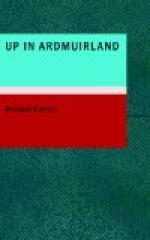It had but one street—if a single straggling line of dwellings along a roadside might be so termed; on one side were cottages, each in its embowering garden, and on the other ran a clear streamlet, which supplied all the residents with abundance of fresh water. Besides these habitations in the village proper, there were others, more pretentious, though simple enough, in the shape of small farms situated in outlying districts which claimed to belong to Lanedon parish, whose dwellers worshiped in the little Norman church.
At one end of the village stood the “British Lion” public-house. It was a quaint old homestead of two stories, with black, oaken interlacing beams in its wattled walls and mullioned windows, retaining the small diamond, leaded panes, long ago discarded by more pretentious contemporaries. Before the door still stood an ancient horse-block, which had served in its time to mount many a lady of olden days; for the inn had once been of no little importance when stage-coaches plying between London and the north, along the old Roman road, daily passed the end of the lane leading to the village. Many a guest of quality, in those days, spent a night in the “British Lion.”
Opposite the inn door, on the other side of the road, a signboard swung in a frame upheld by a massive oaken pillar, under the shelter of a cluster of tall elms; on a marine background, the noble beast that stands for the type of national courage and strength was depicted rampant, his fierce claws raised in defiance of all invaders. Under the sign shone out in golden letters the name, “Stephen Dale.”
The other end of the straggling street was closed by the old church with its squat tower, whose carven doorways and capitals were wont to attract to the place many a traveler learned in archaeology; for it was a famous building in its way, and was honorably mentioned in most manuals of architecture.
The inn and the church had little in common—less, indeed, than an inn and a church in other villages. Stephen Dale’s sole interest in the sacred building was of a temporal nature; he regarded its attractions with satisfaction because they served to bring past his door many a wayfarer who would otherwise never set foot in Lanedon. Such might pass on their way to the church, but would seldom omit to enter the inn on their return journey for a few minutes of rest and refreshment. And a charming place of rest it was! From a stone-paved passage you entered the “house-place,” a large square room, also stone-paved, a step lower than the passage. Its wide chimney had settled on either side, where one could sit warm and comfortable—heedless of winter winds—in the glow of the log-fire burning on the iron “dogs” of the low hearth. In summer its sanded pavement made it a gratefully cool retreat from the sunshine outside. Moreover, Stephen Dale’s renowned home-brewed ale added to the attractions of the house.




